My Dad, the Motorcycle
Man,
and Our Trip to New York
by Martin Varisco, Jr.
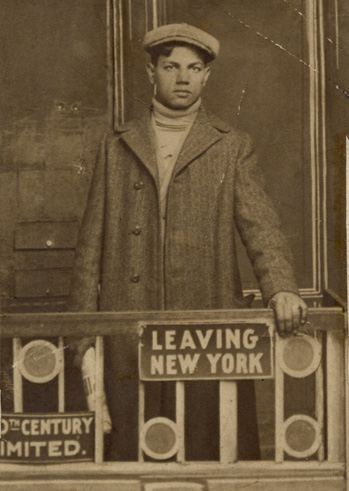
Dad leaving New York City in 1913
|
My Dad, the Motorcycle
Man,
|
Dad leaving New York City in 1913 |
What a delightful pleasure it is whenever we take the time to reminisce about
those days of long ago when we were children. Yet how seldom do we find the
time. It seems that the cares of everyday living don't leave us enough time
to do this. Then, perhaps a friend or relative comes along and something is
said that causes us to get out the family album and that causes us to pause
and reflect about our own pastexperiences. Whatever the reason, It does bring
back a flood of happy memories.
ln looking over our family album I see so many pictures that remind me of those days. There is a picture of my dad, Martin Varisco, Sr., taken when he left New York City to come to Ohio in the spring of 1913. He was born in New York City on April 13,1893 on Elizabeth St. in the Italian section on the Lower East Side. Often he told us of the elevated trains, subways, and streets filled with push carts -- all part of his early life in that crowded city. As a boy he sold newspapers and shined shoes to make a few pennies. While still in New York, Dad took boxing lessons in a gym and developed a life-long interest in the sport.
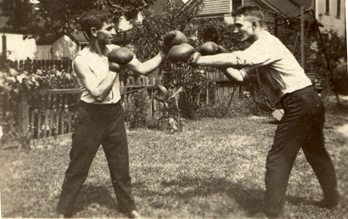
Dad loved boxing, even with the neighbors.
He signed on to work as a section hand on the railroad in 1913, because there
was no work available in the city. This required him to leave home for Ohio,
where he bought a second-hand bicycle which he used to travel about. Those were
the days when the horse and buggy provided the principle means of transportation.
On one of his biking excursions he met Violet Hutchins, the young lady who was
to become his wife. They were married in 1916 and a year later I was born, the
first of four sons. All of us boys were born on my mother's parents farm about
three miles west of the village of Medina.
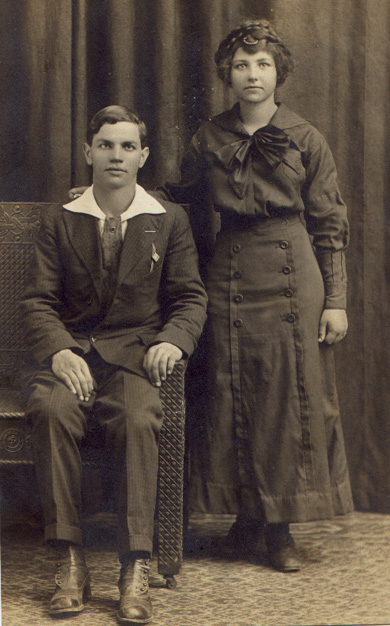
Dad and Mom just before they were married
After the marriage they lived in Cleveland, but my mother and us boys used to
spend most of our summers at my grandparent's farm, until we started school.
My folks thought that the traffic in the Cleveland of 1924 was too much for
a child to walk to school, so I stayed with my grandparents and went to school
in Lafayette, a small village a few miles south of the farm. We went to school
in a horse-drawn bus called a kid wagon, which was driven by my grandfather,
Fred Hutchins. I can still see the old mud road with its single pair of ruts
and the hoofprints of the horses all filled with water.In 1927 Dad started working
as a motorcycle mechanic for the Casino Cycle and Supply Company, located at
68th and Superior Avenue in Cleveland. This was the Indian Motorcycle dealer.
Dad worked there until the early thirties, when the place went out of business
during the great depression. During the six years he worked there, he rode his
Indian back and forth to work six days a week, a round trip each day of over
sixty miles. There were a few times he would stay in the city at a nearby hotel,
when there was severe weather, but this was very seldom. Summer and winter,
rain or snow, he rode through it all.
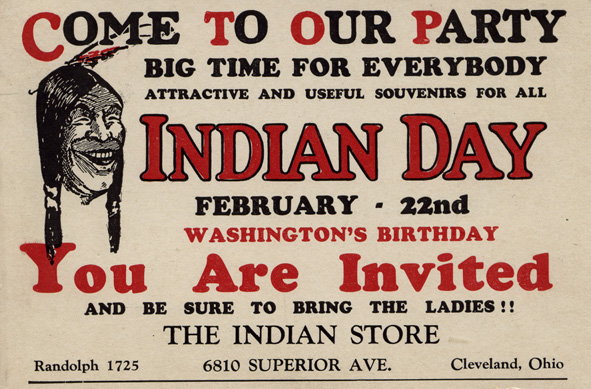
Motorcycles were popular in the 1920s and 1930s. In those days there was no
such thing as a motorcycle gang such as we read about today. There was, however,
the Forest City Motorcycle Club to which many enthusiasts belonged. Each year
the members assembled together and went to an amusement park for a picnic with
their families. Most rode their motorcycles except the ones who had too large
a family. It was an electrifying sight to see up to a hundred motorcycles traveling
together as we went on our way. This annual excursion was called a "gypsy
tour." One of the souvenirs issued each year for this event was a watch
fob, a bronze, octagon-shaped plaque that was attached to a watch by a short
leather strap and allowed the plaque to hang from the watch pocket. Those were
the days when you could buy the famous dollar pocket watches and all men's trousers
had a watch pocket. The watch plaque had an engraved picture of a motorcycle
and sidecar with riders, as well as the name of the motorcycle club and the
date of the current year. The one I still have has the date of 1929, but the
leather strap is gone. I recall that Dad took all four of us boys along. The
three youngest sat in the sidecar and I rode on the back seat of the cycle.
There were all kinds of games and prizes and plenty of good things to eat.
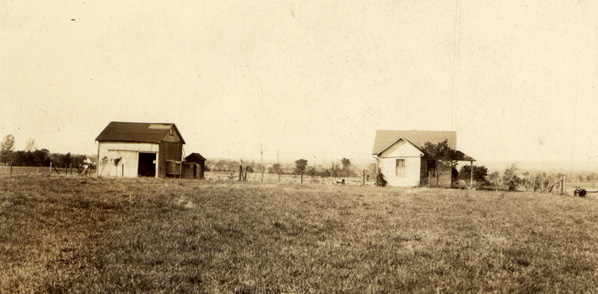
Our house on Harmony St. in Medina. We moved there on April 1, 1927.
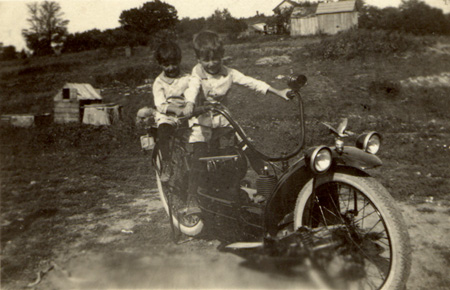
Dad's Ner-a-Car in my Grandpa's back yard
Dad's first motorcycle was called a Ner-a-Car and was black in color with dual
headlights. It had a single cylinder engine which required mixing the oi1 and
gasoline together. The one cylinder was in front of the driver's seat and there
was no protecting frame over it like on later cycles. After this Dad always
had Indian motorcycles, which were painted bright red. My uncle, Ray Hutchins,
had a Harley Davidson motorcycle and the two of them used to brag about which
was the best machine. One of the major differences between the two was that
the Indian had a right hand shift lever and the Harley had the lever on the
left side.Dad's first Indian motorcycle and sidecar in 1924.
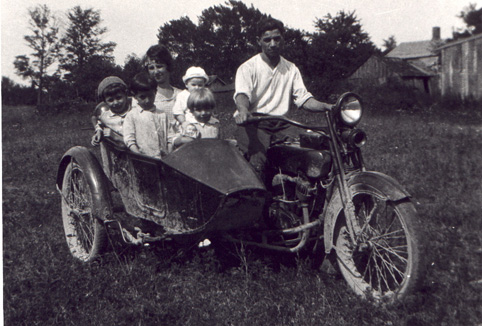
Left to right: Martin, Alfred, Mother with Andrew on lap, Raymond in front
of sidecar, with Dad on the cycle
During the depression, after the motorcycle company had closed, it was
almost impossible to find a job. We had two acres of land at home, so we always
had a large garden and raised a couple of pigs for meat. During this time, some
area farm boys would bring their broken-down motorcycles for Dad to repair.
Most of them had no cash, so they paid with farm produce. One fellow we named
the Potato Kid, because he paid with a winter's supply of potatoes. This was
a lot of potatoes, as there were six mouths to feed. Another one gave us wheat,
which Dad took and had ground into flour. My mother baked homemade bread every
other day, several loaves at a time, in our coal cookstove. Our diet consisted
for the most part of this bread, potatoes and baked beans. As we boys became
teenagers, we delivered newspapers, mowed lawns, raked leaves, spaded small
city gardens and shoveled snow, among other errands, for some of the townspeople.
All of us, together with Mother, would go blackberry picking in season and then
brother Al and I would go door to door in town selling them at ten cents a quart
or three quarts for a quarter. This is how we raised cash to buy our lard and
coffee and things we could not raise ourselves.
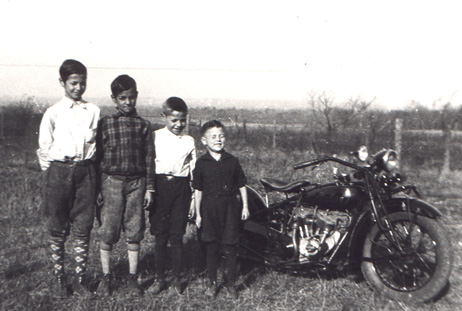
Martin, Alfred, Raymond and Andrew about 1930.
During the early 1930s Dad talked of taking all of us to New York City to see
his relatives, as none of us had ever seen them except for his younger brother
and some friends who drove through from Delaware in a Model A Ford roadster.
Dad never wanted or owned an automobile. He said it made him feel too confined.
So he decided to make a three-wheel car out of his motorcycle. He cut down the
frame from a Model A Ford and used its rear wheels and differential assembly.
Then he removed the rear wheel from his motorcycle and bolted it in the middle
of the front of the Ford frame. Where the motorcycle wheel had been, he inserted
two chain sprockets. One was for the chain that originally drove the rear motorcycle
wheel, and the other sprocket was for a chain to drive the rear Ford wheels.
It was a double chain drive. By 1934 he had completed his first three-wheel
car. The black enclosed body was made of sheet steel. We boys held an old flatiron
on one side, while Dad riveted it to the angle iron framework he had made.
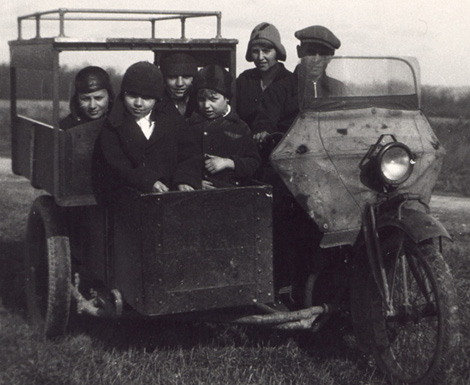
Dad's homemade sidecare in 1930. Left to right: Martin, Raymond, Alfred,
Andrew, Mom and Dad.
Since we did not have enough money to travel to New York City yet, we took a
short ride in it to the Ohio River and a little way into West Virginia. By this
time my brother Al and I each had a paper route. The family decided that to
be able to go to New York we would each save a dollar a week for the next year
and then we could go. In the meantime Dad decided to make another body for his
three-wheel car. The first model had a door on the side, but the second was
open in the back with seats on both sides. In this one we had a lot more room,
almost like a station wagon for space.
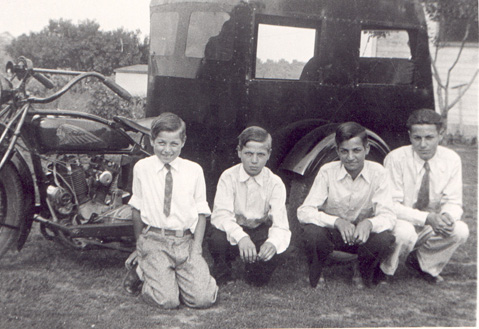
Dad's first three-wheel car in 1934. Left to right: Andrew, Raymond, Alfred
and Martin
We saved the money as planned and in September of 1935 started out for New York
City. We left home about 3 pm on a beautiful, sunny-day. We only went as far
as Brocton, New York, where we stayed in a small, one-room cabin for a dollar.
The next day we ran into a heavy afternoon rain. It was necessary to stop early
so Dad could get dried out. We rented another one-room cabin, which had a wood
stove in it, for another dollar. Dad had no protection as he drove and was soaked,
but all of us remained dry inside the car body. He dried out that night and
the next morning we left early. We followed old route 20 from Cleveland through
Erie, Pennsylvania, Buffalo, Rochester, Syracuse, Utica and Albany, where we
turned south to reach New York City. On the third day of our trip in the afternoon
we arrived in the big city. On entering the city, Dad was confused for awhile
on how the traffic lights regulated traffic. There was not one at each intersection,
but if you saw the next one down the street turn red, you were supposed to stop
at the first intersection you came to and not wait until you reached the traffic
light. After the blowing of horns at us by the cars on the other streets, Dad
realizedwhat to do and then we proceeded without incident. It was amusing to
us in a way how people would gather around to see what kind of contraption we
were riding in, whenever we had to stop at an intersection. Finally, we arrived
where Uncle Pete lived, an apartment building on East 28th street. My uncle
had made arrangements to park our vehicle in an apartment garage nearby. It
was necessary to drive up a steep ramp to several floors above the street level.
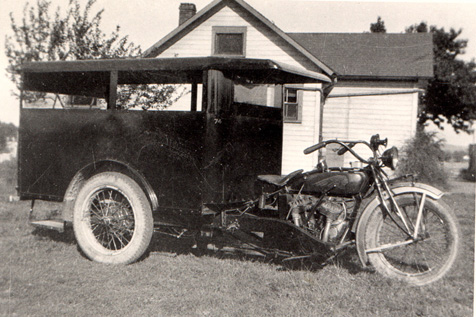
The three-wheel car in which we went to New York City in 1935.
We stayed a week with Uncle Pete and Aunt Sadie. During the week we took daily
rides on the elevated and subway trains. One of the days Dad took us to old
Battery Park and on a boat ride past the Statue of Llberty. The train and boat
rides only cost a nickel for each of us. Also we walked through Chinatown and
other sections of Manhattan. On Saturday afternoon, when Uncle Pete came home
from work, he took us on the subway to Coney Island. We all had a fascinating
time seeing the wonders of this big city. On Sunday morning, when traffic would
be the least, we left and started for Wyoming, Delaware, to visit Dad's younger
brother, Sam, and his sister's family, who lived on a farm. I can still remember
going through the Holland Tunnel as we left the city.
We arrived in Delaware later that day and were surprised that one of the original thirteen states was so rural. At this time Dad's stepmother was living with Uncle Sam. After another enjoyable week with relatives, we left for home. Our trip home was over route 30, the Lincoln Highway. Back then, in 1935, the road was a lot different than it is today. It was narrower and much steeper on the hills and mountains. We had some interesting experiences with many of the truckers. Going up the grades we would pass them, and then they would pass us on the way down. Sometimes the men would lean out of their trucks as we passed each other. As we slowly passed them on the upgrades, they would wave and some even offered us bananas. Sometimes we accompanied the same truck for several miles, passing and being passed.
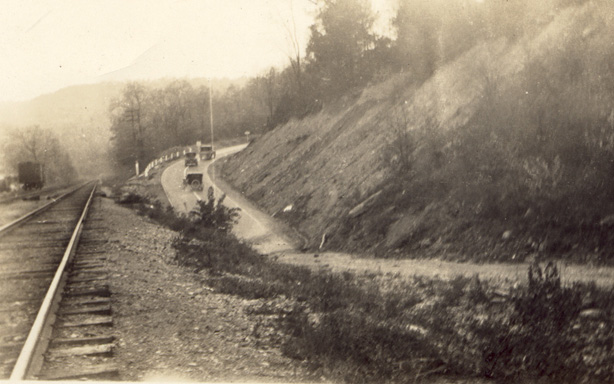
Rt. 30 traveling through Pennsylvania in 1935
One night on the way home we couldn't find any place to stay, as we were in
the mountains. Finally, we saw an abandoned truck body, so we slept in that.
Of course we did not have enough money to stay in rented places all the time,
so we would sleep under the stars sometimes. When we returned home to Medina,
our two-cylinder Indian Chief car had carried us over 1600 miles without a hitch.
That trip was an experience no one in the family will ever forget and we still
like to talk about it.
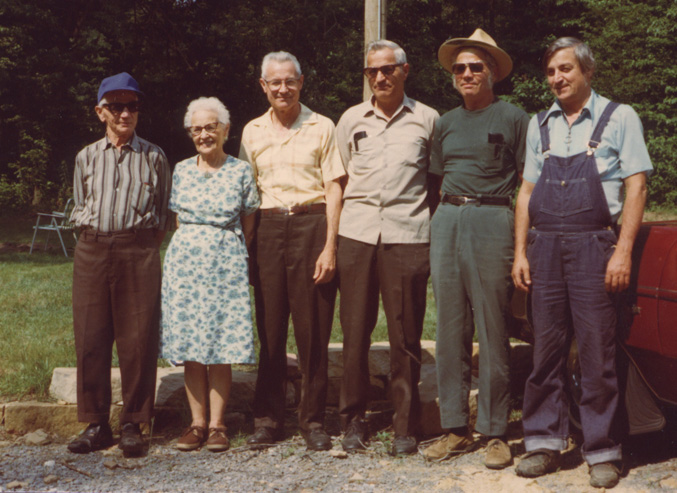
Family Reunion in 1976. Left to right: Dad, Mom, Martin, Alfred, Raymond
and Andrew
Dad passed away at the age of 93 on July 8, 1986. Near the end he was still
quite active for his age and sometimes rode his bicycle to shop around town.
He continued to live at the same address where we moved in 1927. Mother passed
away in November of 1980, just five days before their 64th wedding anniversary.
Dad continued his lifelong hobby of raising canaries. He had large pictures
of his two famous three-wheel motorcycle cars and enjoyed showing them to anyone
who dropped in for a visit and they invariably heard about our trip to the "Big
Apple" more than a half century ago.

the author and his parents about 1918
|
This article was published in Good Old Days November, 1984 Vol. 21, #5, 43-46. |
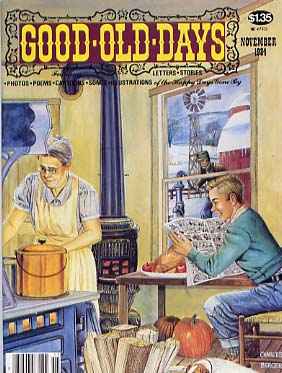 |